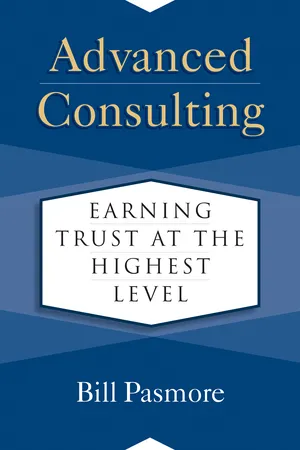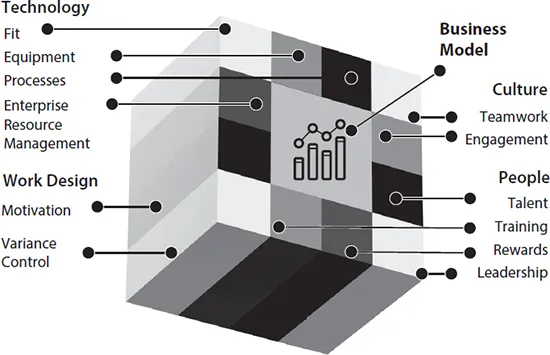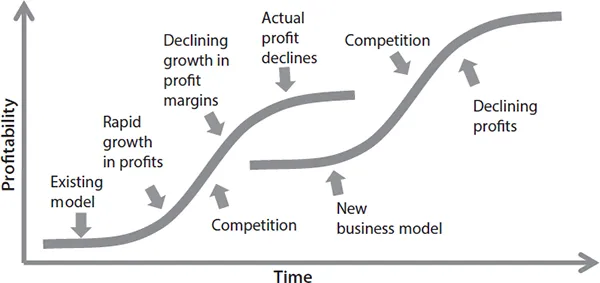![]()
THREE
What You Need to Know, Part 1: Business
In this chapter, I will fill you in on some focal areas for advanced consulting work. Since each of these topics could fill a book on its own, you will need to learn more about the topics that interest you. Think of this as a map of the world rather than a map of your neighborhood.
Advanced consultants operate from a solid base of knowledge. You may have a charming personality or a sharp wit but neither will be of much value when the hard questions need to be answered. Shooting from the hip isn’t advisable. You could get lucky and hit the bull’s-eye, but you are more likely to put your ignorance on display.
Shooting from the hip isn’t advisable. You could get lucky and hit the bull’s-eye, but you are more likely to put your ignorance on display.
None of us knows everything and the world keeps adding things we need to learn. Still, earning trust at the highest level means that you can at least keep up in most conversations if not add something of value. You should also be able to demonstrate deep expertise in your chosen specialty. The profile you need to perfect has been referred to by Tim Brown of IDEO (Brown 2009) as being a “T” player, meaning that you are both broad in your knowledge (the top of the “T”) and deep in your expertise (the stem of the “T”).
Earning an MBA can help, although only about 20 percent of what you learn will be of interest to the CEO. The rest is operational knowledge about things that CEOs delegate to others. Plus, you are not likely to learn as much from an MBA in certain areas as you should. Do you therefore need a PhD? Definitely not, although once again, about 20 percent of what you learn would be extremely valuable. You can learn most of what you need to know from on the job experience, if you hold a responsible general management position in industry or pay attention to strategic conversations as a consultant while you are finding your way. This path takes time but provides immediate credibility if you work at the right level in the right organizations on the right projects. Complemented by more formal courses in a few disciplines, you will be ready to hold your own.
Every industry has its unique language. You can Google a glossary of terms for many industries, which can be helpful if you know you are about to do work there. Still, the best way to pick up the language is to work in the industry or spend time with people who can teach you the dialect. If possible, it would be good to avoid having to interrupt your clients to ask for a translation of what they are saying. If you are working in an industry for the first time, it might be helpful to enlist a colleague to accompany you who can get you up to speed.
Beyond industry-specific lingo, there are common concerns that cut across industries that are worth taking the time to understand. I’ve selected a few topics to discuss here but a complete strategic business education is beyond the scope of this book. To learn more, you should consider working in industry, taking a formal course of study, enrolling in executive education, and/or reading the Wall Street Journal regularly and stopping to look up subjects that are not familiar to you. Learning about business is like learning a foreign language; with or without instruction, the only way to master it is to spend time working at it.
If you are engaged in advanced consulting, it’s assumed that you know business basics. You can read a balance sheet or P&L, understand how to interpret analysts’ reports, and know the components of a 10-K. You understand markets, know how to improve supply chains, understand the pros and cons of enterprise IT systems, and recognize what a stage-gate model for R&D does. What you may need to add to your working vocabulary are things that keep the occupants of C-suites awake at night. As discussed in the last chapter, performance, strategy, talent, organization design, culture, innovation execution, and working with boards are often on that list.
Organizational Performance
All leaders are concerned about the performance of their organizations. Not all leaders know how to manage performance. Some are victims of superstitious learning. When asked how they manage performance, these individuals often answer with simple statements such as “I just hire great people and let them do what they know how to do,” or “I set clear goals and follow up with people regularly.” These statements sound good, but mask the complexity involved in creating a high-performance, high-commitment work system. Note that the two statements just mentioned are saying exactly the opposite thing. One suggests that high performance is based on trusting people to set their own goals and the other relies upon supervisory control. While both sound true, both cannot be true, at least in the same situation.
As an advanced consultant, you will have seen a variety of high- and low-performing teams and organizations. You will have also reviewed research related to the factors that underlie high performance. Because of your experience and knowledge, it’s acceptable to say, “OK, but there’s actually a bit more involved in creating sustainable high performance.” Your goal is to help leaders understand how to manage performance, not simply hope that their actions will produce great performance time and again.
Consider this. Performance varies in every organization from year to year. If leaders really understood how to control performance, why would performance ever decline? The truth is, there are many factors that affect performance, some of which can’t be controlled. Most leaders are trying to achieve the best performance possible under the conditions they encounter rather than actually enhancing performance over time. Enhancing performance requires a more in-depth analysis of the factors that affect performance and what can be done about them, not simply using the same approach you have always used and hoping for the best. This is a little like buying a sports car and expecting it to perform the same way in the summer as it will in ice or snow. An active approach to performance enhancement requires that something be done differently.
An active approach to performance enhancement requires that something be done differently.
Performance enhancement begins with a business model that holds promise for improved results. Imagine sitting at the executive table at Barnes & Noble or Waterstones and watching the sales of printed books decline, or being on the executive team at a traditional bank and realizing that your main services are about to be replaced by an app. With the wrong business model in place, worrying about upgrading technology, improving employee engagement, enhancing culture, or paying more attention to people—issues associated with executing the current business model—would make no sense.
You can also imagine how hard it must have been for leaders in those organizations to give up on their old business models, despite the apparent declines. Who would want to be the CEO who has to tell the board, investors, customers, and employees, “As of today we are declaring that our business model is no longer viable. We will get back to you soon with a new model but you should know that, basically, everything you currently own is worthless and as of tomorrow, no one here has a job.”
FIGURE 3.1 Enhancing Performance
Finding a viable business model isn’t easy but sometimes it’s even harder to make the old business model continue to work. Instead, we need a business model with some upside. That means that we are providing customers with something they value at a price they are willing to pay.
Once the right business model is in place, we can begin to examine the factors that could enable significant improvements. Each of the broad areas of technology, work design, culture, and talent has many facets that need to be considered, and the overall design of the elements need to be aligned with one another.
Since the focus is on performance, it usually makes sense to begin with the design of the technical system, which includes selecting the right technology for the task at hand, the optimal equipment, the work processes and spatial layout, and an effective enterprise resource management system to coordinate it all.
Finding a viable business model isn’t easy but sometimes it’s even harder to make the old business model keep working.
The technical system design choices may have to bend to accommodate other factors affecting performance. Paying attention to motivational factors may lead to changes in how the technology is designed or arranged, and certainly in how processes are designed and controlled. Motivation starts with the way jobs are designed and grouped together. Work should provide individuals with a degree of variety, autonomy, meaningfulness, and feedback and also with a sense of achievement. While some individuals may prefer a monotonous job without responsibility because their minds can drift elsewhere, in a high-performance system there’s no room for mental loafing. We need people to be fully present and constantly thinking about ways the system can improve.
Speaking of people, we need talented individuals who have the skills and predisposition to take on the challenges inherent in the work as well as being willing to learn new skills as coming changes will require. We need to make certain these people are receiving the training they need and that they are rewarded for the right behaviors. We also need to provide them with the kind of leadership that brings out the best in them.
Often, if we do all these things right, we produce a culture that supports high performance. In some instances, further attention to enhancing teamwork or making certain that we are engaging people in the right level of decision making may be required.
Once we adopt a viable business model and design the individual components that affect performance, we should stand back to reflect on how the pieces fit together. We might conduct a value chain analysis to make certain the work we are doing from the beginning to the end is adding value to the product or service and that nothing is wasted or meaningless. We can also conduct engagement surveys or organizational assessments once the system is operational to make certain that we haven’t anything on the people side.
All of this work involves “picking up the rug to see what’s beneath it,” which may expose things that need to change. While this is necessary, your detective work may not please everyone, especially if some people are made to look bad because they supported processes better suited to low performance than high performance. Should this concern you? Yes, because you will be relying on some of the same people to make the changes that will lead to higher performance.
Your detective work may not please everyone.
Creating a “safe container” for redesigning work systems involves setting some ground rules up front. First, individuals are not to be blamed for what was. Everyone supported the way things were done, so the responsibility for the old system lies with all of us. Second, if it is decided that changes are needed, the organization should commit to doing everything it can to help people find a new home, provided that they are willing to be retrained or reassigned as required. Third, to the extent possible, people should be involved in decisions that affect them directly, such as how jobs are designed or how their work will be performed. Finally, the vision for the future should serve as a litmus test against which design decisions are made.
Strategy
A quick review of the major approaches to strategy formulation demonstrates that they are all based on understanding trends in the business market, competitors’ strategies, unique strengths of the firm, and new business opportunities. The idea is to find a niche that is likely to provide competitive advantage in order to survive in the short run and prosper in the future. Here are some concepts associated with strategy with which you should be familiar.
The McKinsey S-curve is based on Schumpeter’s economic theory of creative destruction (Schumpeter 1942). It holds that when a firm develops a strategy that is profitable, others are attracted to the space and competition grows. As it does, the original firm and all others who are operating according to the strategy begin to experience declining profits. In a search for greater profitability, firms then develop new strategies that provide advantages over the old strategy, thereby increasing profitability, until the new strategy also attracts competition and the cycle repeats. Clayton Christensen, a Harvard professor, studied the difficulties innovative firms have when their strategies are adopted by others (Christensen 1997). Instead of jumping onto the next S-curve, which is unproven and even unprofitable when it first appears, originators wait too long to move and thereby lose their long-term competitive advantage. Christensen called the difficult choice between maintaining existing profits by staying on the old S-curve versus jumping onto the new one, “the innovator’s dilemma.”
The Five Forces model, created by another Harvard professor, Michael Porter, holds that to gain long-term competitive advantage, firms need to deal with five forces that threaten their survival: (1) the competitive rivalry of their industry, (2) the threat of new entrants, (3) the bargaining power of suppliers, (4) the bargaining power of customers, and (5) the threat of substitute products or services (Porter 1985). As the competitive rivalry of the industry increases, it is important for firms to develop distinctive strategies for reducing the bargaining power of suppliers and customers while reducing the threat of new entrants or substitute products. Suggestions on how to do those things fill several large volumes.
FIGURE 3.2 The McKinsey S-Curve: Adopting New Business Models as Old Ones Become Obsolete
The growth-share matrix, developed by Bruce Henderson of the Boston Consulting Group (BCG), advises leaders to assess the combination of market share and future market demand for products before making investments (Henderson 1979). Products that have high future growth potential and that the company offers exclusively are areas that warrant significant investment and are termed “stars”; products that have low growth futures and are offered by many competitors are labeled “dogs.” Products that generate profits but for which there would be little future growth are labeled “cash cows,” indicating that they should be “milked” for as long as possible without significant investments to prop up sales. “Question marks” are like the new S-curves discussed by McKinsey; they are untested models that could be either sinkholes for cash or the start of a new industry.
FIGURE 3.3 BCG Growth-Share Matrix
Business model innovation was championed by Adrian Slywotzky, a Mercer Management Consulting partner whose book Profit Patterns explained that selling products in stores (the bricks-and-mortar model) is only one of approximately 33 ways that firms can generate profits (Slywotzky 1999). He argues that when existing models come under attack, firms need to adopt new models, or a new series of models, to stay attuned with industry trends and customer preferences. The release of his book coincided with the emergence of online business model...



